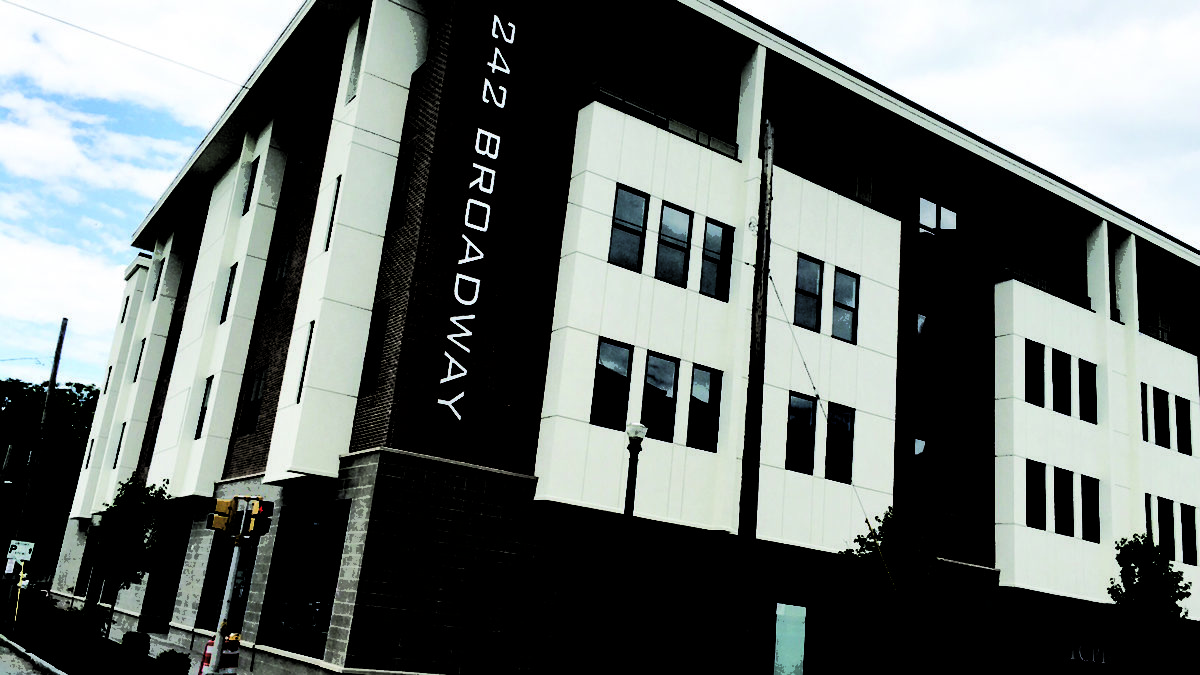
Dryvit's NewBrick featured on a building in Schenectady, N.Y.

Dryvit’s NewBrick featured on a building in Schenectady, N.Y.
Dryvit Systems, Inc., the leading manufacturer of exterior insulation and finish systems (EIFS) in North America, has created a breakthrough new brick product that can dramatically increase brick installation productivity and provide new options for architects, contractors, and building owners who wish to include brick as part of a new or renovated building’s exterior cladding.
At 1/12th the weight of traditional clay brick, NewBrick is a lightweight insulated brick product that is coated with a specially formulated finish. It matches clay brick’s classic size and appearance, but offers state-of-the-art engineering and technology to meet today’s building challenges, including:
- A built in horizontal alignment guide that eliminates the need for support pans and mortar joint spacers and also establishes the perfect 3/8” spacing for the mortar, reducing installation time and saving money.
- No brick ties are needed, eliminating penetrations through the water resistive barrier.
- Reducing the amount of steel, concrete and engineering on the project
- Lowering costs to transport the product to and around the job site
- Easier and safer to work with, especially on multi-story construction
- Installs faster
Dryvit President and CEO Mike Murphy called Dryvit’s patent-pending NewBrick product a significant advancement in the way buildings are constructed. “We are very excited about the opportunities NewBrick presents for architects, installers and building owners,” said Murphy. “With NewBrick, we are providing contractors an exciting new product that improves daily productivity, reduces occupational injury, provides greater creative flexibility and results in a better building process. For owners and architects, NewBrick results in a better building envelope at a lower installed cost.”
“Although NewBrick can be installed directly over tilt-wall, precast and concrete masonry units, the larger benefits can be realized when NewBrick is installed over an Outsulation® system,” explained Murphy. These benefits include:
- Full system warranty for 10+ years, depending on system, including the air/water-resistive barrier
- Continuous Insulation (CI), meeting IECC requirements
- Compliance with NFPA 285 fire testing
- Compliance with California’s Title 24, Part 6 Energy Code
- Can contribute to LEED points
Winford “Buck” Lindsay, FAIA, a principal of the Atlanta-based architectural firm of Lindsay Pope Brayfield Clifford & Associates, specializes in the design of hotels and frequently specifies brick for exterior finishes. “I think Dryvit has something with its NewBrick product that is going to rock the market,” said Lindsay. “For architects, brick has always been one of the top choices in cladding because building owners love its classic appearance. Yet traditional brick presents challenges when specified in taller buildings because of its heavy weight, which requires additional structural components to safely anchor brick to the upper floors of a building’s exterior. Dryvit’s lightweight NewBrick reduces the need for structural reinforcement and also allows much faster installation. Both of these factors will translate into cost savings.”
Jory Walker, principal of Beecher Walker Architects, a Salt Lake City-based firm, said the authenticity of Dryvit’s NewBrick and its light weight will give it major advantages in the marketplace. “For architects like me designing buildings in seismic zones, where brick on upper elevations is very impractical and cost prohibitive, this new brick product opens a whole new world,” said Walker. “All of a sudden now we can use brick on multi-story buildings. When you hold this new product in your hand, it’s got a feeling of a clay brick, yet it has superior insulated value and its installation process is very easy. I think it’s an amazing product that’s going to have a major impact in the marketplace.” Both Lindsay and Walker are looking forward to specifying NewBrick in upcoming projects.
Weight matters
At 1/12 the weight of conventional face brick and 1/4 the weight of thin brick, NewBrick provides significant advantages to the installer, particularly in multi-story construction. Heavy materials require extra handling and equipment. With NewBrick, it is easy to handle on the jobsite and easy to apply without strain. This results in a faster-to-the-wall methodology for installers which increases daily production.
Bill Gatto, the Vice President of MGM Masonry, Inc. in Schenectady, N.Y., recently installed 12,000 square feet of NewBrick on a new-build, multi-story, mixed-use project over the Outsulation Plus MD System by Dryvit. “Everyone involved in a project is always looking to save money while constructing a quality building,” said Gatto. “The biggest selling point for Dryvit’s NewBrick was me telling the owner that it would cost less than thin brick because we could eliminate a whole step in the process since we didn’t need to prep the wall to accommodate the heavier thin brick. The second piece was me telling him that we could match the selected thin brick with respect to color and texture. He gave me a brick and Dryvit matched it and he was very happy with that.”
Gatto underscored the time savings associated with the lightweight NewBrick when positioning the product on the job site compared to clay brick. “Getting NewBrick to the wall itself is a much easier process than clay brick,” said Gatto. “Clay brick comes on pallets and you always have to be concerned with how much weight is being put on scaffolding. With NewBrick you never have to worry about this. They are lightweight and easy to move around the scaffold. Loading a scaffold with clay brick takes a substantial amount of time, especially on multi-story buildings, and it involves significant lift equipment costs.”
“There’s a huge market for thin brick right now with mixed used buildings and hotels,” said Gatto. “If Dryvit can tap into that market and give you the same look for a lower cost and a higher R-value, I think NewBrick is going to crush the market.”
